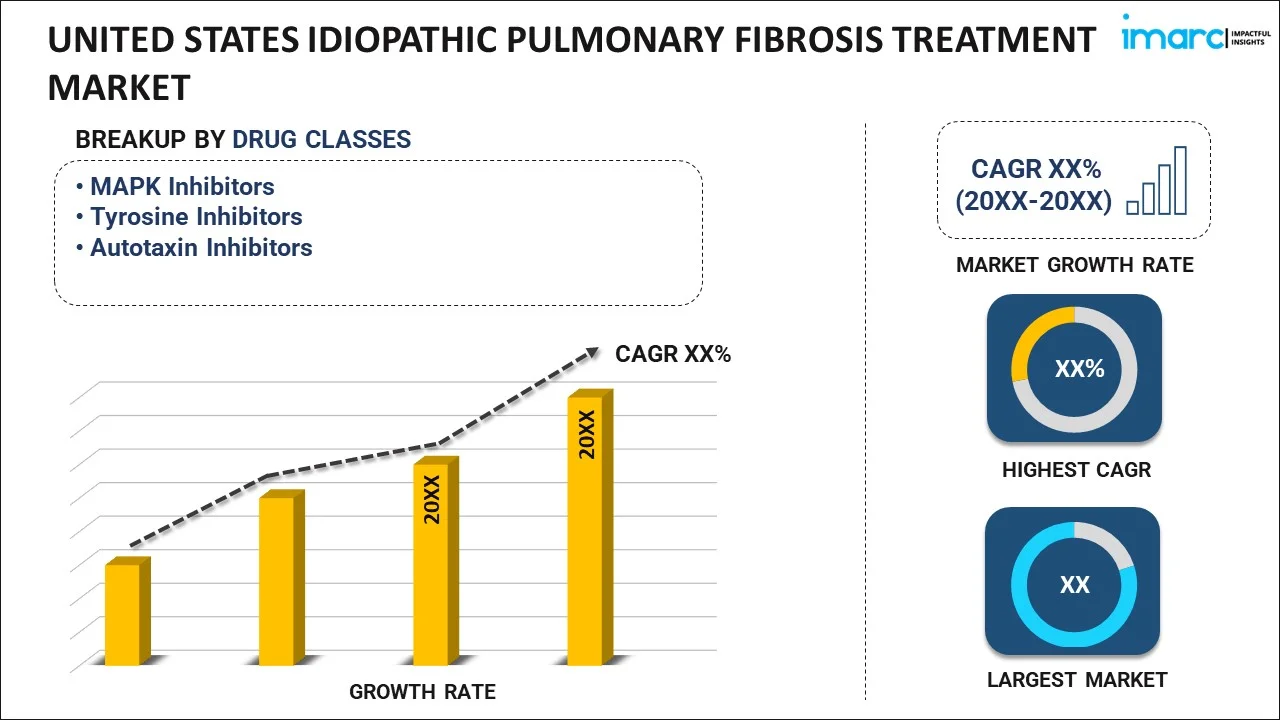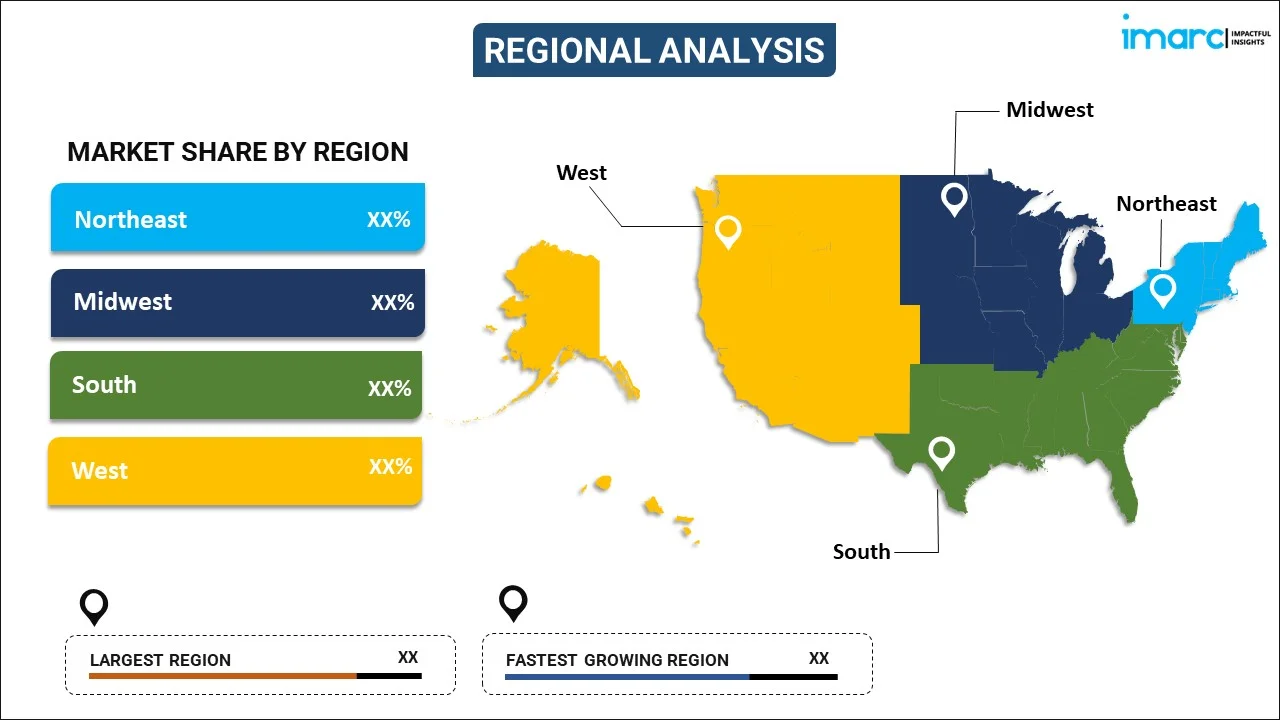
United States Idiopathic Pulmonary Fibrosis Treatment Market Report by Drug Class (MAPK Inhibitors, Tyrosine Inhibitors, Autotaxin Inhibitors), End User (Hospitals, Long-term Care Facilities, and Others), and Region 2025-2033
Market Overview:
The United States idiopathic pulmonary fibrosis treatment market size reached USD 2,859.5 Million in 2024. Looking forward, IMARC Group expects the market to reach USD 5,050.8 Million by 2033, exhibiting a growth rate (CAGR) of 6.2% during 2025-2033.
|
Report Attribute
|
Key Statistics
|
|---|---|
|
Base Year
|
2024
|
|
Forecast Years
|
2025-2033
|
|
Historical Years
|
2019-2024
|
|
Market Size in 2024
|
USD 2,859.5 Million |
|
Market Forecast in 2033
|
USD 5,050.8 Million |
| Market Growth Rate 2025-2033 | 6.2% |
Idiopathic pulmonary fibrosis (IPF) is a form of progressive lung disease that causes a buildup of scar tissues in the lungs. This condition hinders the oxygen-carrying functionality of the lungs, thus resulting in breathing difficulties. IPF is diagnosed through various chest imaging evaluations, including antibody tests, lung biopsies, and pulmonary function tests. It can be treated by prescribing anti-fibrotic drugs and supportive treatment options, such as oxygen therapy and palliative care.
United States Idiopathic Pulmonary Fibrosis Treatment Market Trends:
The increasing prevalence of fibrotic diseases, especially among the geriatric population, represents the key factor driving the IPF treatment market growth in the United States. Changing living standards and the increasing consumption of nicotine-based products are further catalyzing the market growth. Other than this, increasing health consciousness, rising awareness regarding the availability of effective strategies for managing IPF, and rapid advancements in diagnostic techniques are propelling the market growth. Moreover, extensive research and development (R&D) activities for introducing novel medicines are creating a positive outlook for the market in the country.
Key Market Segmentation:
IMARC Group provides an analysis of the key trends in each sub-segment of the United States idiopathic pulmonary fibrosis treatment market report, along with forecasts at the country and regional level from 2025-2033. Our report has categorized the market based on drug class and end user.
Breakup by Drug Class:

- MAPK Inhibitors
- Tyrosine Inhibitors
- Autotaxin Inhibitors
Breakup by End User:
- Hospitals
- Long-term Care Facilities
- Others
Breakup by Region:

- Northeast
- Midwest
- South
- West
Competitive Landscape:
The competitive landscape of the industry has also been examined along with the profiles of the key players.
Report Coverage:
| Report Features | Details |
|---|---|
| Base Year of the Analysis | 2024 |
| Historical Period | 2019-2024 |
| Forecast Period | 2025-2033 |
| Units | Million USD |
| Segment Coverage | Drug Class, End User, Region |
| Region Covered | Northeast, Midwest, South, West |
| Customization Scope | 10% Free Customization |
| Post-Sale Analyst Support | 10-12 Weeks |
| Delivery Format | PDF and Excel through Email (We can also provide the editable version of the report in PPT/Word format on special request) |
Key Questions Answered in This Report
The United States idiopathic pulmonary fibrosis treatment market was valued at USD 2,859.5 Million in 2024.
We expect the United States idiopathic pulmonary fibrosis treatment market to exhibit a CAGR of 6.2% during 2025-2033.
The rising prevalence of chronic lung and fibrotic diseases, along with the growing consumer awareness regarding the presence of effective idiopathic pulmonary fibrosis preventive and management treatment, is primarily driving the United States idiopathic pulmonary fibrosis treatment market.
The sudden outbreak of the COVID-19 pandemic had led to the postponement of elective idiopathic pulmonary fibrosis treatment procedures to reduce the risk of the coronavirus infection upon hospital visits and interaction with healthcare professionals or medical equipment.
Based on the drug class, the United States idiopathic pulmonary fibrosis treatment market has been bifurcated into MAPK inhibitors, tyrosine inhibitors, and autotaxin inhibitors. Among these, tyrosine inhibitors currently hold the majority of the total market share.
Based on the end user, the United States idiopathic pulmonary fibrosis treatment market can be segmented into hospitals, long-term care facilities, and others. Currently, hospitals exhibit a clear dominance in the market.
On a regional level, the market has been classified into Northeast, Midwest, South, and West.
Need more help?
- Speak to our experienced analysts for insights on the current market scenarios.
- Include additional segments and countries to customize the report as per your requirement.
- Gain an unparalleled competitive advantage in your domain by understanding how to utilize the report and positively impacting your operations and revenue.
- For further assistance, please connect with our analysts.
 Inquire Before Buying
Inquire Before Buying
 Speak to an Analyst
Speak to an Analyst
 Request Brochure
Request Brochure
 Request Customization
Request Customization




.webp)




.webp)












